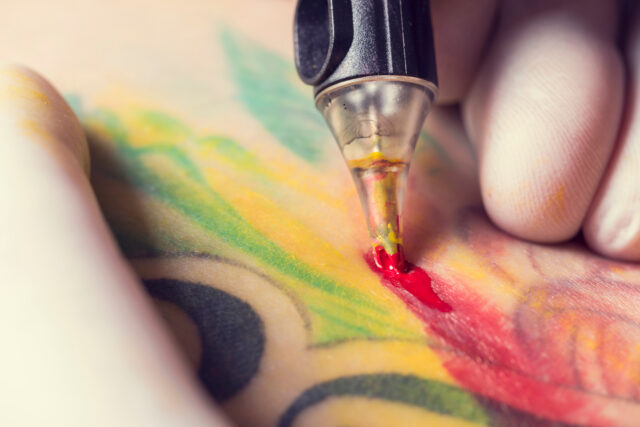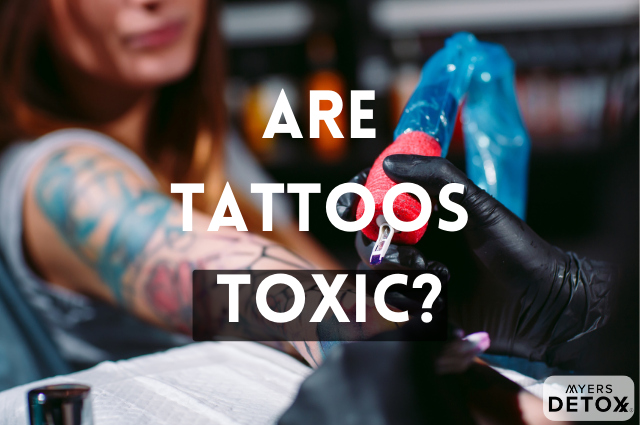Is the ink on your skin wreaking havoc in your body?
Tattoos can serve as a unique source of self-expression and often hold deep meaning to us., which is why this form of body art is so popular. In fact, it’s estimated that approximately 24% of the US population has at least one tattoo inked into their skin[1].
We know that the ritual of tattooing the body goes as far back as Egyptian times, but seldom do we stop to consider the fact that tattoos are, indeed, a potential source of heavy metals and other toxic compounds.
In this article, you’ll learn:
- The commonly used heavy metals in tattoo ink
- How tattoos can interfere with the natural electromagnetism of your body
- Why red-colored ink is the most harmful of all
- The best way to mitigate tattoo ink toxicity
Heavy Metals: The Dangers of Tattoos

It may seem harmless enough, but when you get a tattoo, you’re not only coloring the surface of your skin but injecting ink into your body, where it may eventually meet with your blood supply and lymphatic system, potentially accumulating in your brain, organs and tissues.
The conversation around the safety of tattoos seems to have been swept under the rug. People don’t think of the potential toxicity of tattoos.
First, it’s important to understand that tattoo inks are not classified as pharmaceutical or cosmetic and have no FDA approval. In other words, there is no regulation around what types of compounds can be used in these inks[2].
Second, and perhaps most shockingly, most tattoo inks are made intentionally with heavy metals because these create the vivid colors people want[3].
For example, cobalt, cadmium, and mercury are often used as bases for green, blue, yellow, and red inks. This is highly concerning, particularly with red ink, which is known to contain cadmium and mercury—a toxic highly toxic substance with a litany of detrimental health consequences[4].
Meanwhile, iron and titanium create the colors brown, white, black, and violet. And the heavy metals cadmium and aluminum are used to obtain different tones of brightness[5].
What’s most surprising is that this information is widely available and seemingly unquestioned by most health authorities.
And we’re not talking about a small quantity of inks that contain these toxins either. One study found that of 30 inks analyzed, 87% contained aluminum, and 67% contained titanium[6].

Just a handful of the harmful effects that these heavy metals are associated with include[7][8][9]:
- Fatigue – disruption of mitochondrial function
- Cellular decay and death
- Inflammation
- Oxidative damage
- Damage to the brain, nervous system, liver, lungs and kidneys
- Bone loss
- Mental health issues
- Hundreds of symptoms
All of these systemic changes caused by heavy metals may then go on to create even more detrimental conditions that could impact nearly every system and organ in your body. Simply put, heavy metals are no joke, and their use in tattoo ink should not be taken lightly.
But there’s another aspect to the danger of tattoo ink that’s discussed even less than the heavy metals themselves: electromagnetism.
Electromagnetism and Tattoo Ink
The health of your skin and tissues can determine how well your body conducts its electrical signals. When you have a scar, for instance, it can disrupt the flow of electrical impulses that normally stream through your body, sending information. This is evidenced most clearly by issues that arise from scar tissue in the heart, causing AFib and other heart abnormalities. That said, irregularities in the skin can impact any area of your body. And you guessed it—tattoos act similarly to scars in this way[10][11].
This is often seen in MRIs, where people with tattoos may experience a burning sensation. This sensation arises due to the heavy metals, acting as magnetic elements, in the tattoo ink deposited in their skin[12][13].
Studies show that iron oxide, for example, may react with the external magnetic field and become magnetized[3].
While research into heavy metals, tattoos, and your electromagnetic field is still in its infancy, this raises concern about how your tattoos may interfere with the magnetic fields around you, particularly as we’re dealing with stronger electromagnetic frequencies today more than ever.
How to Support Your Body’s Natural Detox Mechanisms In the Removal of Heavy Metals from Tattoo Ink

Honestly, when I see someone with a lot of tattoos i do think they are beautiful. And a cool form of self-expression. And some are pure works of art. But I can’t help but think about the toxins they are adding to their body – and the health consequences of that choice. But there is a lot you can do to remove toxins if you have tattoos.
There are a handful of helpful steps you can take if you already have a tattoo and some best practices to follow if you’re considering getting one. If you’re freshly inked, these steps are even more important. But even if you’ve had a tattoo for a while, giving your body the support it needs to help it push out unwanted toxic compounds is warranted.
#1 Help Your Body Eliminate Heavy Metals Naturally
The most direct way to support your body post-tattoo is to assist its ability to remove heavy metals. If you’re freshly tattooed, jump on board as quickly as possible to get your detox pathways up and running, as the first few days post-ink session, your body will be inundated with toxic compounds.
That said, anyone with a tattoo, old or new, will benefit from supporting your body’s natural detox mechanisms on the regular so you can detox from heavy metals. While new tattoos are the most concentrated in metals, these toxic compounds can continue to leach into your body for years or even decades.
The tricky piece here, however, is that the longer you wait to detox, the more time heavy metals have to bury themselves deeper into your cells and tissues. This is why it’s vital that you choose a detox method that’s tailored to target hard-to-get toxins like heavy metals.
For this process to truly work, you’ll need not only liver support but also nutrients that can help your body release stored toxic compounds, neutralize them, and then remove them from your body.
It may sound like a tall order, but that’s exactly why I formulated CitriCleanse. CitriCleanse is a three-in-one formula specifically designed to reach those stubborn toxic metals stuck deep in your tissues and gently surround and usher them out of your body, naturally. To accomplish this, CitriCleanse contains three potent ingredients: grapefruit pectin, cilantro extract, and fulvic minerals.
- Grapefruit pectin is a unique nutrient that can bind heavy metals (and many other toxins), accelerating their removal while supporting overall digestive health.
- Cilantro extract is a natural chelator that assists your body in removing heavy metals while supporting liver function and protecting against oxidative stress.
- Fulvic minerals help to push heavy metals out of your body, neutralizing and releasing them while supporting a healthy inflammatory response and overall detoxification.
With these three nutrients combined, you get an all-in-one comprehensive heavy metal detox formula that targets deep-seated metals and relieves your body of its toxic burden.
#2 Support Your Lymphatic System
In addition to directly targeting the source of toxicity, you’ll also want to support your lymphatic system, as toxins from tattoos can easily accumulate in the lymph nodes surrounding your injection site.
While your heart acts as a pump for your blood supply, your lymphatic system requires physical activity to keep things flowing. This means you need to get active if you want to help your lymph detox. Some of the best ways to get your lymphatic system moving include jumping on a mini trampoline (rebounder), walking, or running.
You can also use hot and cold therapy, which allows your blood vessels to contract and relax, pushing your lymphatic system along as they do. This could look like taking a warm shower and then turning the water all the way to cold for 30 seconds and then back to warm, repeating three to five times.
If you really want to get your lymph moving, you can also see a lymphatic massage specialist who can do lymphatic drainage for you. For those with fresh tattoos, this option will be especially beneficial.
#3 Look For Clean Ink
The good news is that there appear to be some inks out there that are lower in toxic chemicals and may even be free of them. First, choosing black ink over colored ink will naturally help you avoid some of the most concerning metals like mercury. However, if you do your research, you may find inks that are actually all-natural, but I would recommend talking with the company or artist to make sure their inks are free of heavy metals.
Takeaway
If you have a tattoo or are thinking about getting one, it’s important to remember that your skin is highly permeable, and therefore, what you put on it can easily be absorbed into your body. While there are a handful of tattoo ink companies out there making safer products, the vast majority of commonly used ink is riddled with toxins like heavy metals.
Even if your tattoo is decades old, these toxic compounds can stick around in your body, accumulating in the organs, bones, brain and fat. And given the research of heavy metals, they can certainly contribute or cause health issues at some point.
Old or new, if you have a tattoo on your body, you should seriously consider doing a heavy metal detox with a formulation like CitriCleanse. While other detox methods may support liver function, CitriCleanse is specifically formulated to dig deep into your tissues and liberate stored toxins.









